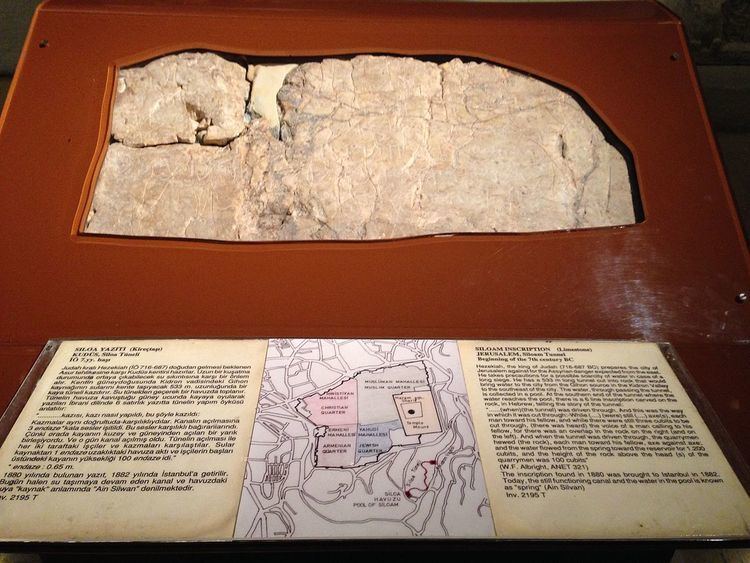Material Stone Created c. 700 BCE Identification 2195 T | Discovered 1880 | |
 | ||
Present location Istanbul Archaeology Museums | ||
The Siloam inscription or Shiloah inscription (כתובת השילוח) or Silwan inscription is a passage of inscribed text found in the Siloam tunnel which brings water from the Gihon Spring to the Pool of Siloam, located in the City of David in East Jerusalem neighborhood of Shiloah or Silwan. The inscription records the construction of the tunnel, which has been dated to the 8th century BCE on the basis of the writing style. It is the only known ancient inscription from the wider region which commemorates a public construction work, despite such inscriptions being commonplace in Egyptian and Mesopotamian archaeology.
Contents
It is among the oldest extant records of its kind written in Hebrew using the Paleo-Hebrew alphabet, a regional variant of the Phoenician alphabet.
The inscription is at permanent exhibition at the Istanbul Archaeology Museum.
History
The tunnel was discovered in 1838 by Edward Robinson. Despite the tunnel being examined extensively during the 19th century by Robinson, Charles Wilson, and Charles Warren, they all missed discovering the inscription, probably due to the accumulated mineral deposits making it barely noticeable. According to Easton's Bible Dictionary, in 1880 a youth (Jacob Eliahu, later Jacob Spafford) wading up the tunnel from the Siloam Pool end discovered the inscription cut in the rock on the eastern side, about 19 feet into the tunnel. The inscription was surreptitiously cut from the wall of the tunnel in 1891 and broken into fragments which were recovered through the efforts of the British Consul in and placed in the Istanbul Archaeology Museum.
The ancient city of Jerusalem, being on a mountain, was naturally defensible from almost all sides but its major source of fresh water, the Gihon spring, was on the side of the cliff overlooking the Kidron valley. The Bible records that King Hezekiah, fearful that the Assyrians would lay siege to the city, blocked the spring's water outside the city and diverted it through a channel into the Pool of Siloam.
Translation
As the inscription was unreadable at first due to the deposits, Professor Archibald Sayce was the first to make a tentative reading, and later the text was cleaned with an acid solution making the reading more legible. The inscription contains 6 lines, of which the first is damaged. The words are separated by dots. Only the word zada on the third line is of doubtful translation—perhaps a crack or a weak part.
The passage reads:
... the tunnel ... and this is the story of the tunnel while ...the axes were against each other and while three cubits were left to (cut?) ... the voice of a man ...called to his counterpart, (for) there was ZADA in the rock, on the right ... and on the day of thetunnel (being finished) the stonecutters struck each man towards his counterpart, ax against ax and flowedwater from the source to the pool for 1,200 cubits. and (100?)cubits was the height over the head of the stonecutters ...The inscription hence records the construction of the tunnel; according to the text the work began at both ends simultaneously and proceeded until the stonecutters met in the middle. However, this idealised account does not quite reflect the reality of the tunnel; where the two sides meet is an abrupt right angled join, and the centres do not line up. It has been theorized that Hezekiah’s engineers depended on acoustic sounding to guide the tunnelers and this is supported by the explicit use of this technique as described in the Siloam Inscription. The frequently ignored final sentence of this inscription provides further evidence: "And the height of the rock above the heads of the laborers was 100 cubits." This indicates that the engineers were well aware of the distance to the surface above the tunnel at various points in its progression.
While traditionally identified as a commemorative inscription, one archaeologist has suggested that it may be a votive offering inscription.
A diagram of a transcription of the Paleo-Hebrew of the inscription is available at this link.
Possible exhibition in Israel
In 2007, Jerusalem Mayor Uri Lupolianski met with Turkey's ambassador to Israel, Namık Tan, and requested that the tablet be returned to Jerusalem as a "goodwill gesture." Turkey rejected the request, stating that the Siloam inscription was Imperial Ottoman property, and thus the cultural property of the Turkish Republic. President Abdullah Gul said that Turkey would arrange for the inscription to be shown in Jerusalem for a short period.
